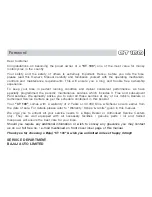
3.
4.
Secure the adjuster lock nut.
Loosen the brake rod adjuster lock nut
and screw brake rod downward until
there is noticeable free play between rod
and master cylinder.
5. Turn in the brake rod until it lightly
touches the master cylinder, then turn it
out by approx.
turns (for proper
free play).
6. Tighten the brake rod adjuster lock nut.
position so that its top end is approx. 12
18 mm (0.47
0.71 in) below the
footrest top end.
adjuster lock nut in securing the brake rod
Adjuster bolt (for pedal height) 6. Pedal
2. Lock nut
3.
nut
7.
4.
5.
F.
and tires
2. Tires
Specifications should
follows:
(0.47 -0.71
Free play 13 15 mm
(0.51 -0.69 in)
be changed as
Standard tire
or
Yokohama
Maximum load limit
166 kg
Cold
pressure:
Up to 90 kg
1.6
(198
load
psi
kg (198
load
-204 kg
2.0
load (Maximum
128 psi
High speed riding
2.0
REAR
119 kg
or
Yokohama
279 kg (615
2.0
psi)
2.3
2.3
I.8 mm (0.03
G. Drive chain
1. Tension check
NOTE:
Before checking and/or adjusting, rotate
rear wheel through several revolutions and
check tension several times to find the
tightest point.
Check and/or adjust chain
tension with rear wheel in this “tight chain”
position.
Inspect the drive chain with the center
stand put up. Check the tension at the
position shown in the illustration. The
normal vertical deflection is approximate-
ly 10
20 mm (0.4 0.8 in). If the
deflection exceeds 20 mm (0.8 in) adjust
the chain tension.
a. 20 mm (0.8 in)
2.
a.
b.
C.
e.
80
Tension adjustment
Remove the cotter pin of the rear wheel
axle nut with pliers.
Loosen the rear wheel axle nut.
Loosen the lock nuts on each side. To
tighten chain turn chain puller adjusters
clockwise. To loosen chain turn adjusters
counterclockwise and push wheel for-
ward. Turn each adjuster exactly the
same amount to maintain correct axle
alignment. (There are marks on each side
of rear arm and on each chain puller; use
them to check for proper alignment.)
After adjusting, be sure to tighten the
lock nuts and the rear wheel axle nut.
Insert the cotter pin into the rear wheel
axle nut and bend the end of the cotter
pin as shown in the illustration (if the
nut notch and the cotter pin hole do not
match, tighten the nut slightly to match).
Summary of Contents for XS650SE
Page 1: ......
Page 4: ...CHAPTER 1 GENERAL INFORMATION l l MACHINE IDENTIFICATION a 1 l 2 SPECIAL TOOLS...
Page 39: ......
Page 45: ......
Page 55: ......
Page 76: ......
Page 77: ......
Page 78: ......
Page 79: ...XS650E Supplementary FOR XS650E MODELS AFTER ENGINE SERIAL NO 2FO 006501...
Page 84: ..._ _ _I __ l i _ _ I l R...
Page 108: ......
Page 109: ......
Page 110: ......
Page 111: ......
Page 112: ......
Page 116: ...MAINTENANCE AND LUBRICATION CHART PERIODIC MAINTENANCE EMISSION CONTROL SYSTEM 3...
Page 117: ...t c c...
Page 140: ......
Page 141: ...Supplementary...
Page 149: ...2 Troubleshooting inspection...
Page 150: ...LOW BEAM DOES NOT LlGHT WHEN HIGH BEAM IS DEFECTIVE...
Page 161: ......
Page 162: ......
Page 163: ......
Page 164: ......
Page 165: ...Supplementary FOR XS650SE MODELS AFTER ENGINE SERIAL NUMBER 2FO 114241...
Page 174: ...R W wire to 118...
Page 175: ...119...
Page 186: ......
Page 187: ......
Page 188: ......
Page 189: ......
Page 190: ......
Page 200: ...1...
Page 202: ...Torque Specifications A Nut...
Page 212: ......
Page 213: ......
Page 214: ......
Page 215: ......
















































